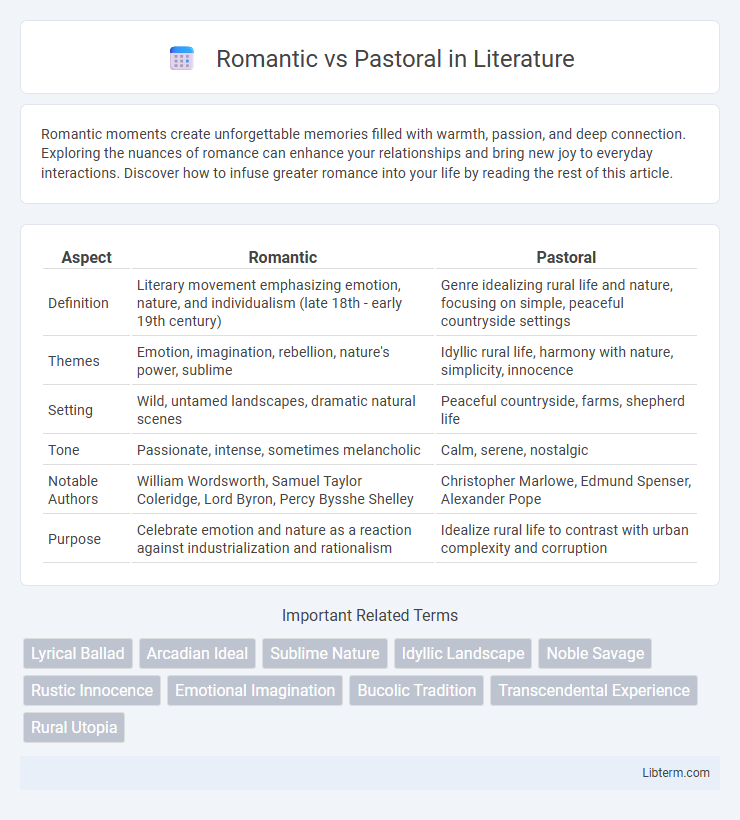Romantic moments create unforgettable memories filled with warmth, passion, and deep connection. Exploring the nuances of romance can enhance your relationships and bring new joy to everyday interactions. Discover how to infuse greater romance into your life by reading the rest of this article.
Table of Comparison
| Aspect | Romantic | Pastoral |
|---|---|---|
| Definition | Literary movement emphasizing emotion, nature, and individualism (late 18th - early 19th century) | Genre idealizing rural life and nature, focusing on simple, peaceful countryside settings |
| Themes | Emotion, imagination, rebellion, nature's power, sublime | Idyllic rural life, harmony with nature, simplicity, innocence |
| Setting | Wild, untamed landscapes, dramatic natural scenes | Peaceful countryside, farms, shepherd life |
| Tone | Passionate, intense, sometimes melancholic | Calm, serene, nostalgic |
| Notable Authors | William Wordsworth, Samuel Taylor Coleridge, Lord Byron, Percy Bysshe Shelley | Christopher Marlowe, Edmund Spenser, Alexander Pope |
| Purpose | Celebrate emotion and nature as a reaction against industrialization and rationalism | Idealize rural life to contrast with urban complexity and corruption |
Introduction: Defining Romantic and Pastoral
Romantic literature emphasizes intense emotion, individualism, and the sublime aspects of nature, often exploring human imagination and personal experience. Pastoral literature idealizes rural life and landscapes, presenting nature as peaceful and harmonious, typically featuring shepherds and rustic settings. Both genres highlight nature but contrast in tone and thematic focus, with Romanticism embracing complexity and passion, while Pastoral evokes simplicity and tranquility.
Historical Origins and Literary Context
Romantic literature, emerging in the late 18th century, originated as a reaction against Enlightenment rationalism, emphasizing emotion, individualism, and the sublime in nature. Pastoral literature, dating back to ancient Greece and Rome, idealizes rural life and the simplicity of nature, often serving as a backdrop for exploring human virtues and simplicity. The Romantic movement reinterpreted pastoral themes with heightened emotional depth and a focus on the untamed aspects of the natural world, contrasting the often serene and orderly pastoral tradition.
Core Themes of Romanticism
Romanticism centers on intense emotion, individualism, and the sublime experience of nature, contrasting the pastoral idealization of rural life with deeper explorations of human imagination and existential struggles. Romantic works often emphasize the power of creativity and the spirit's rebellion against industrialization and social constraints, highlighting awe, melancholy, and transcendence. Core themes include a fascination with the supernatural, the valorization of the artist-genius, and a profound connection to untamed landscapes as symbols of freedom and mystery.
Core Themes of Pastoral Literature
Pastoral literature centers on the idealization of rural life, emphasizing themes such as nature's simplicity, harmony between humans and the natural world, and the contrast between innocence and corruption. Core elements include shepherds as symbols of purity and peace, the celebration of rustic landscapes, and the exploration of pastoral idylls that evoke a sense of nostalgia and escape from urban complexity. These themes distinguish pastoral works from romantic literature, which often delves deeper into emotion, individualism, and the sublime aspects of human experience.
Nature in Romantic vs Pastoral Works
Romantic literature emphasizes the sublime and emotional power of nature, often portraying it as a source of inspiration, spiritual renewal, and individual freedom. Pastoral works idealize rural life, presenting nature as a serene, harmonious backdrop for shepherds and simple folk, symbolizing innocence and simplicity. Both genres celebrate nature, but Romanticism highlights its wild, transformative force, while Pastoral focuses on its peaceful, orderly qualities.
Representations of Emotion and Imagination
Romantic art emphasizes intense emotion and vivid imagination, often portraying turbulent feelings through dramatic landscapes and dynamic compositions that evoke awe and individual experience. Pastoral themes depict serene, idyllic rural settings celebrating harmony with nature, where emotions are tranquil, reflecting simplicity and contentment rather than passion. The Romantic movement pushes emotional depth and creative freedom far beyond the restrained, peaceful moods found in pastoral representations.
Human-Nature Relationship: Contrast and Comparison
Romantic literature emphasizes an emotional and often idealized connection between humans and nature, highlighting individual experience and the sublime beauty of untamed landscapes. Pastoral works portray nature as a peaceful, orderly realm where human life harmonizes with rural simplicity, often idealizing agricultural settings and seasonal cycles. While Romanticism explores the awe-inspiring power of nature and its role in personal transformation, Pastoral tradition focuses on the gentle coexistence and routine interaction between humans and their natural environment.
Influential Authors and Key Works
William Wordsworth and Samuel Taylor Coleridge are seminal figures in Romantic literature, with works like "Lyrical Ballads" emphasizing emotion and individualism. Pastoral literature, exemplified by Edmund Spenser's "The Shepheardes Calender" and Virgil's "Eclogues," idealizes rural life and nature's simplicity. Both movements shaped literary traditions by contrasting the emotional intensity of Romanticism with the serene, idealized themes of Pastoral poetry.
Lasting Impact on Modern Literature
Romantic literature revolutionized modern storytelling by emphasizing individual emotion, imagination, and the sublime, influencing genres like Gothic fiction and modern poetry. Pastoral themes continue to inspire contemporary works by idealizing nature and rural life, offering a counterpoint to urbanization and industrialization in literature. Together, Romanticism and Pastoral literature shape modern literary explorations of human connection to nature and self-expression.
Conclusion: The Enduring Appeal of Both Traditions
Romantic and Pastoral traditions endure due to their distinct yet complementary portrayals of nature and human emotion, with Romanticism emphasizing intense individual experience and sublime landscapes, while Pastoral idealizes rural simplicity and harmony. Their continued relevance is evident in literature, art, and modern environmental discourse, reflecting a timeless dialogue between human creativity and the natural world. This duality enriches cultural expression by balancing emotional depth and idyllic representation.
Romantic Infographic

 libterm.com
libterm.com